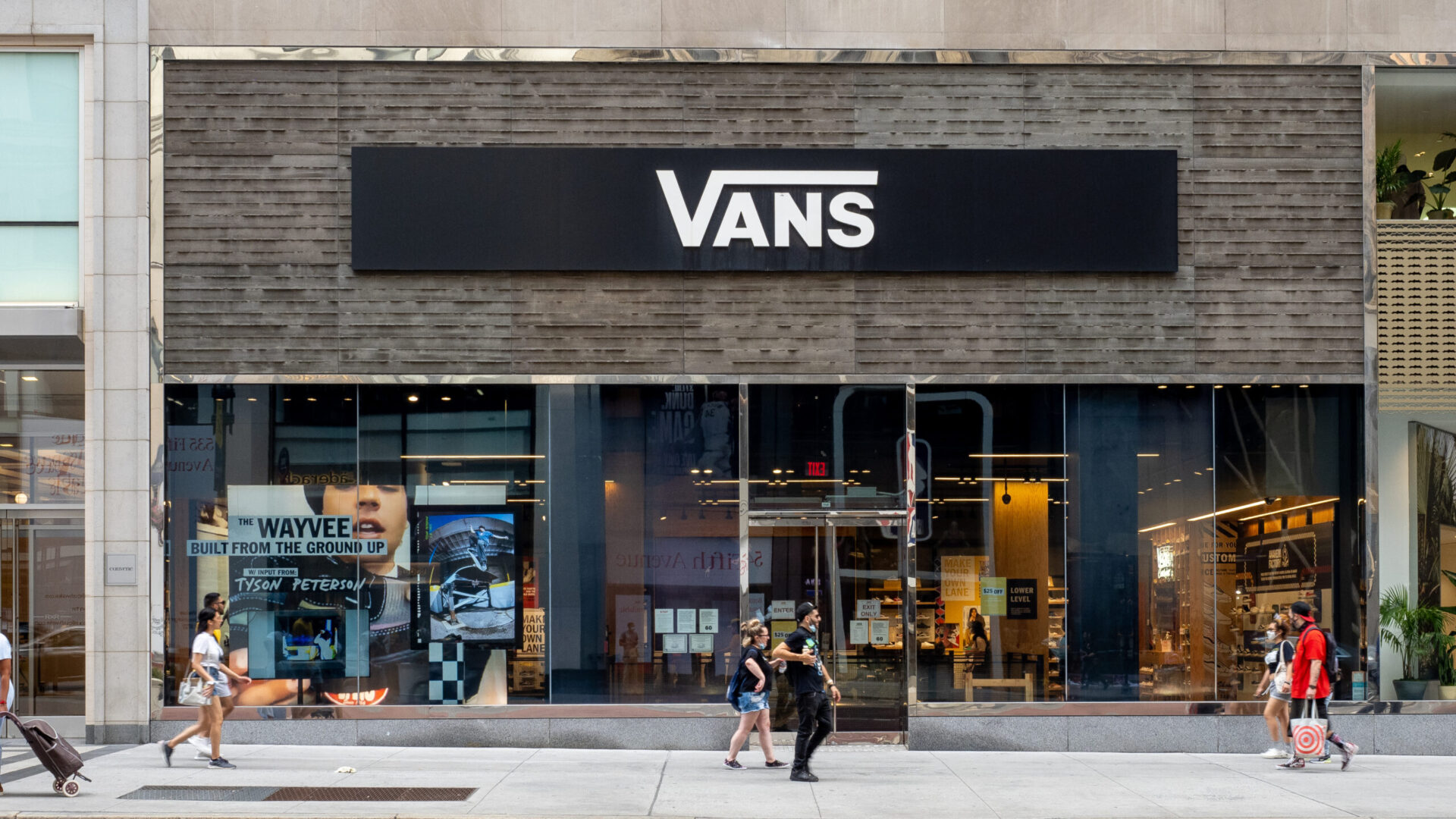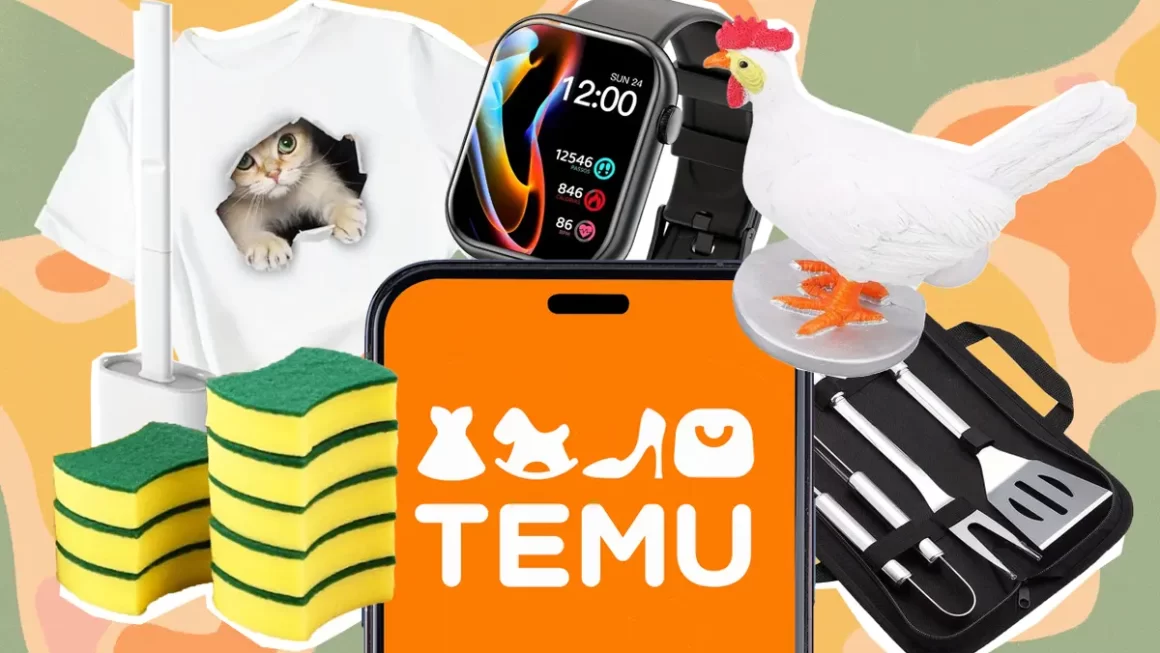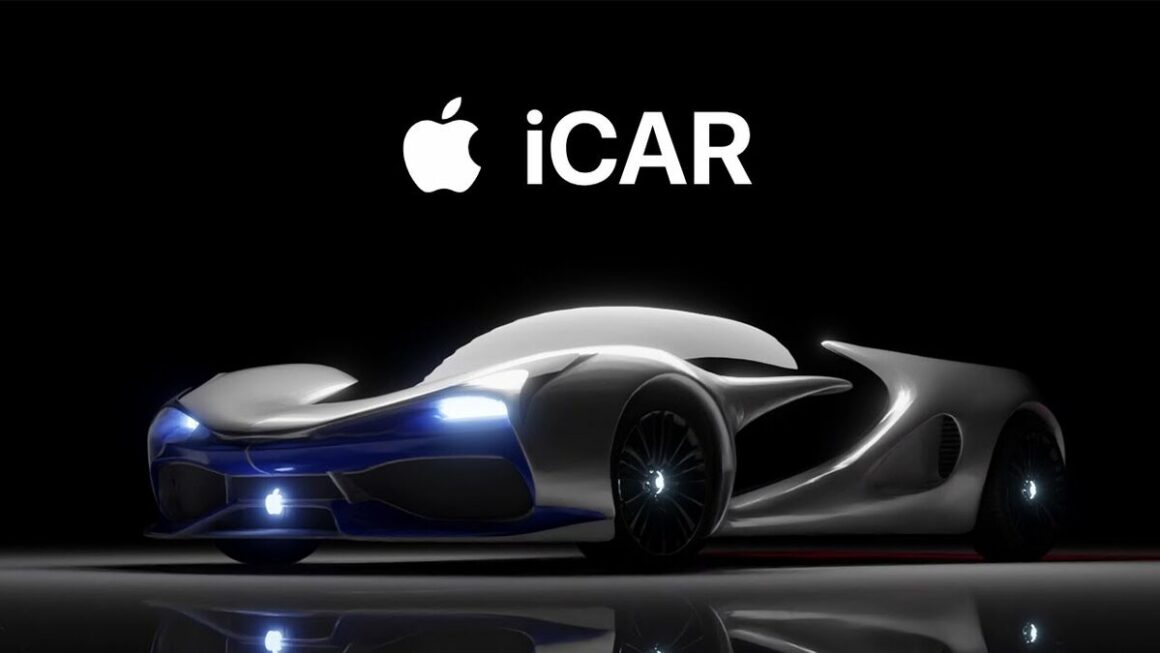The Vans brand stands as a testament to the enduring power of authenticity, individuality, and counterculture within the world of footwear and lifestyle. Established in 1966 in Anaheim, California, by Paul Van Doren and his brothers Jim and Gordon, Vans emerged as a brand rooted in the skateboarding and surfing subcultures of Southern California. What began as a modest shoe store soon transformed into a global icon that not only influenced fashion but also left a mark on music, art, and street culture. The company is headquartered in Anaheim, California, and is currently owned by VF Corporation.
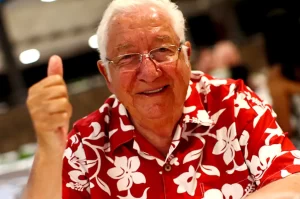
Vans is known for its skateboarding shoes, which were originally designed for the surfing and beach community. The shoes are characterized by their durable canvas uppers, vulcanized rubber soles, and signature “Off the Wall” logo.
The brand’s first shoe, the “Authentic,” reflected its commitment to genuine, functional design – a value that remains at the core of Vans’ identity today. As the brand evolved, so did its product offerings, with iconic silhouettes like the Slip-Ons, Era, and Old Skool becoming synonymous with Vans’ distinctive style.
From skateboarders and punk rockers to artists and sneaker enthusiasts, Vans has managed to bridge subcultures and unite people under the banner of authenticity. The “Off the Wall” ethos, introduced in the late ’70s, encapsulated this spirit – an invitation to break free from conventions and embrace personal creativity.
In the 1980s, Vans expanded its product line to include apparel and accessories. The company also began to sponsor professional skateboarders and BMX riders, which helped to further popularize its brand.
Today, Vans is a global brand with a wide range of products. The company’s shoes are still popular among skateboarders and BMX riders, but they are also worn by people of all ages and walks of life. Vans is also known for its association with music and art, and the company has collaborated with a number of artists and musicians over the years.
Vans Marketing Strategies: Carving Authenticity and Cultural Connection
Vans, with its iconic footwear and lifestyle offerings, has etched a distinctive place in the hearts of consumers worldwide. This renowned brand’s success is underpinned by a shrewdly devised set of marketing strategies that have propelled it beyond being just a footwear company, turning it into a cultural phenomenon. Let’s delve into the key marketing strategies that have woven Vans into the fabric of contemporary lifestyle and fashion.
1. Subcultural Integration:
Vans’ marketing strategy is rooted in the world of subcultures, particularly skateboarding and surfing. The brand authentically embraces these subcultures, aligning its image with their rebellious and creative spirit. This connection resonates with the youth, evoking a sense of community and belonging.
Here are some examples of how Vans integrates itself into different communities:
Skate Culture: As an iconic skate shoe brand, Vans remains deeply rooted in the skate scene. It sponsors top professional skaters, supports grassroots events, and releases limited edition shoes designed specifically for skateboarding. The close relationship with skateboarding culture helps Vans stay relevant and appealing to young skateboarders looking for high-quality, durable footwear.
Music Festivals: Vans often partners with music festivals around the globe, such as Warped Tour (punk/emo), Welcome To Rockville (metal), and Leeds Festival (indie). Sponsoring these events allows Vans to showcase its support for alternative music genres and engage with festivalgoers who share similar interests.
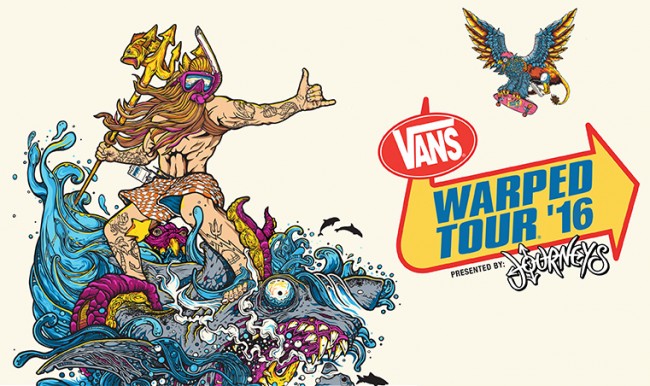
Action Sports: Vans actively promotes surfing, snowboarding, motocross, and other action sports through team riders, contests, and specialized gear lines. By aligning itself with extreme sports, Vans positions itself as a go-to brand for those pursuing adventurous lifestyles.
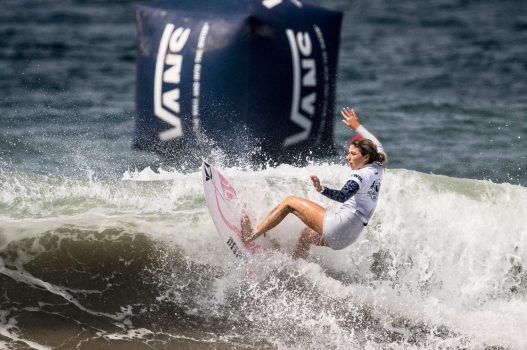
Fashion Industry: Vans collaborates with popular contemporary labels like Opening Ceremony, Fear Of God, and A-COLD-WALL* to create exclusive apparel capsules and sneakers. These partnerships expose Vans to a wider range of fashion-conscious individuals seeking statement pieces that combine functionality with style.
LGBTQ+ Community: Vans released a pride collection in 2019, including rainbow checkerboard slip-on shoes and pride flag graphic T-shirts. This move demonstrated solidarity with the queer community and expanded Vans’ reach to include allies and members of the LGBTQ+ community searching for inclusive brands.
By maintaining its credibility within these subcultures, Vans establishes itself as more than a brand – it’s a genuine representation of the lifestyle it supports.
2. Creative Collaborations:
Vans’ knack for partnering with artists, designers, musicians, and other brands has been pivotal to its marketing success. These collaborations transcend mere business deals; they’re creative collaborations that amplify Vans’ appeal.
Vans also leverages creative collaborations as part of its marketing strategy to maintain relevance and connect with new audiences. Some notable collaborations include:
Marc Jacobs: In 2018, Vans partnered with renowned fashion designer Marc Jacobs on a limited-edition shoe collaboration inspired by his grunge-inspired Fall/Winter 2018 runway show. The resulting platform sneakers featured embroidered floral patterns and studded detailing, reflecting both Vans’ classic silhouette and Jacobs’ unconventional approach to fashion.
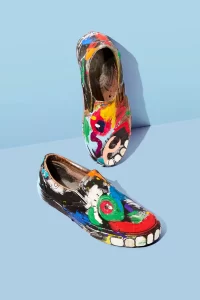
Nintendo: Vans joined forces with Nintendo to release a collection based on beloved video game characters like Mario, Donkey Kong, and Legend of Zelda. The colorful designs incorporated iconic elements from the games onto classic Vans styles, capturing the hearts of nostalgic gamers and younger generations discovering retro classics.
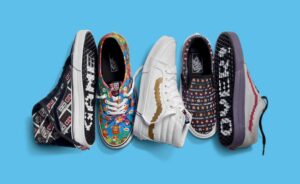
Peanuts: Vans paid homage to Charles M. Schulz’s beloved comic strip characters with a series of Snoopy and Woodstock prints on Classic Slip-On shoes. The playful graphics added a whimsical touch to the classic canvas sneaker, resonating with adults who grew up reading Peanuts and kids discovering the gang for the first time.
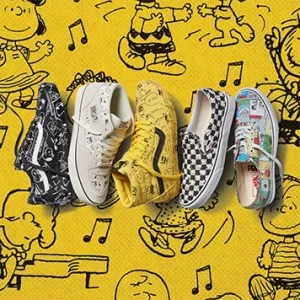
Led Zeppelin: Vans honored the legendary rock band Led Zeppelin with a limited-edition shoe collection celebrating the group’s 50th anniversary. Featuring intricate embroidery and premium leather construction, the shoes were available in classic models like the Authentic and Slip-On, giving fans a chance to wear a piece of musical history on their feet.
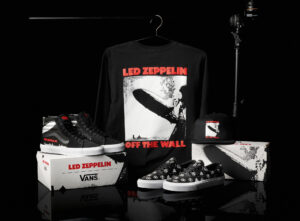
By merging its iconic designs with external artistic visions, Vans consistently produces products that are not just shoes but cultural artifacts.
3. Grassroots Engagement:
Vans’ marketing strategy is characterized by its hands-on engagement with its core community. The brand actively participates in grassroots events, sponsoring skateboarding and surfing competitions, music festivals, and art exhibitions.
Vans recognizes the importance of fostering connections with local communities and supporting emerging artists. Here are several ways Vans executes grassroots marketing efforts:
House of Vans: Vans opened permanent indoor venues called “House of Vans” in London, Chicago, and Brooklyn. These spaces host free concerts, art exhibitions, film screenings, and workshops for local residents. By providing accessible cultural experiences, Vans strengthens ties with nearby neighborhoods while positioning itself as a supporter of arts and culture.
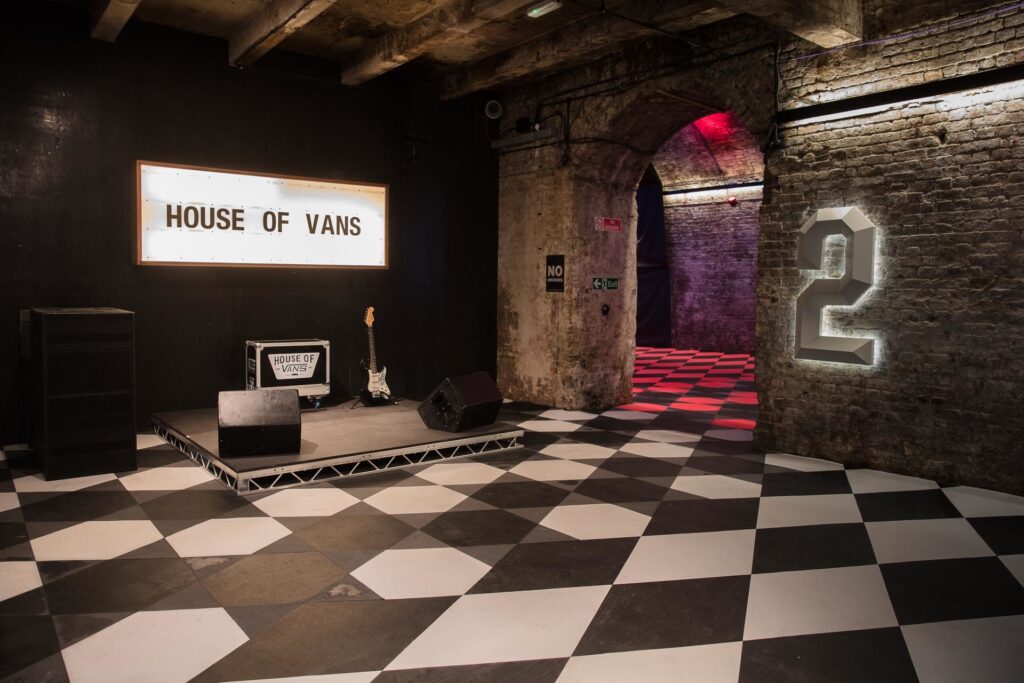
Van Doren Invitational: Since 2003, Vans has hosted the annual Van Doren Invitational, an invite-only skate competition featuring elite professionals competing in unique formats. Each event takes place at distinct locations worldwide, allowing Vans to spotlight underrated skate scenes and promote local talent.
Custom Culture Collection: Encouraging self-expression and individualism, Vans launched the Custom Culture Collection, where customers could design their own shoes using a digital toolbox of colors, patterns, and text options. Participants submitted their one-of-a-kind designs for consideration, with winners receiving $20,000 in cash prizes plus the opportunity to see their designs produced and sold globally.
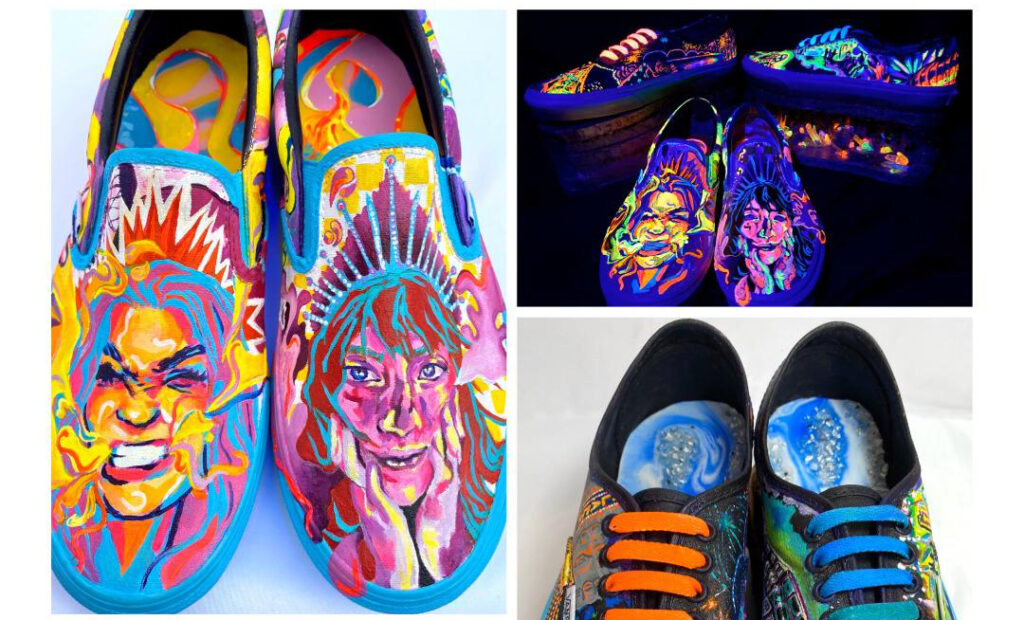
Local Artist Collaborations: Vans frequently teams up with regional artists to produce limited-edition shoes and clothing items. For example, Vans worked with Los Angeles-based artist Deana Lawson to create a women’s collection inspired by her powerful portraits exploring black identity and representation. Such projects emphasize Vans’ commitment to supporting diverse creators and connecting with local communities.
This tangible involvement doesn’t just generate brand exposure; it demonstrates Vans’ commitment to the very subcultures it embodies. By aligning with these events, Vans solidifies its place as a supporter of creative expression.
4. Authenticity Over Celebrity:
While some brands rely heavily on celebrity endorsements, Vans leans more towards authenticity and relatability. Instead of banking solely on star power, Vans maintains a consistent image that resonates with everyday people. The company’s advertisements often feature real skaters and individuals who genuinely connect with the brand’s values.
Here are some examples of how this plays out:
Skate Team Ambassadors: Vans selects professional skaters, snowboarders, surfers, BMX riders, and other action sports athletes to represent the brand based on their dedication to their craft rather than just their fame. These team ambassadors embody the spirit of Vans as they push boundaries within their respective disciplines and inspire others to do the same.
Supporting Emerging Talent: Vans actively supports young, passionate individuals pursuing careers in action sports or creative fields. Through programs such as the Vans Next Wave Grant and the Vans Park Series, Vans helps fund aspiring skaters, photographers, musicians, and more, fostering growth in these industries and nurturing future leaders.
Brand Activations: Rather than hosting flashy events centered around celebrities, Vans creates engaging activations focused on sharing the stoke of action sports and creativity. Events like Vans Snow Days bring together top international snowboarders to ride and teach beginners, while the Vans Warped Tour (before its final run) celebrated punk music and alternative culture through interactive experiences like record label booths and DIY workshops.
Emphasizing Product Quality: Vans consistently delivers high-quality footwear, apparel, and accessories designed for durability and performance. By focusing on product excellence, Vans attracts loyal customers who value quality and trustworthiness over fleeting celebrity trends.
This approach strengthens its appeal as a brand for the people, rooted in genuine experiences.
5. Omni-Presence:
Vans’ marketing strategy covers a wide range of touchpoints. It maintains a robust online presence through its website and social media platforms, engaging with fans and sharing stories that resonate with its audience. Simultaneously, Vans boasts a network of physical stores that serve as community hubs, reinforcing its offline presence and providing an immersive brand experience.
Here are some specific tactics used by Vans:
E-commerce Website: Vans operates an online storefront showcasing its entire product range, including exclusive releases and collaborations not found in physical stores. Shoppers can browse, purchase, and track orders from anywhere in the world.
Social Media Presence: With millions of followers across multiple social media platforms, Vans stays active daily by posting new content, responding to comments, and engaging with audiences. From Instagram videos highlighting skate tricks to Twitter updates about new product drops, Vans keeps its audience informed and entertained.
Influencer Outreach: Vans partners with micro-influencers and industry experts who share their love for the brand through sponsored posts and stories. These influencers often have smaller but dedicated followings, helping extend Vans’ reach without relying solely on mainstream celebrities.
Brick-and-Mortar Locations: While many retail chains struggle, Vans continues expanding its global network of physical stores. Stores feature immersive environments reflecting local cultures and streetscapes, encouraging visitors to explore and connect with the brand offline.
Event Attendance: Vans participates in trade shows, conventions, and festivals related to action sports, music, fashion, and more. By attending these events and offering hands-on experiences, Vans remains visible to target audiences and cultivates long-lasting relationships beyond just selling merchandise.
Vans employs omnipresence as a marketing strategy to maintain visibility across various platforms and channels. This approach ensures that people can interact with the brand seamlessly wherever they go.
In essence, Vans’ marketing strategies revolve around embracing subcultures, fostering creative collaborations, nurturing community engagement, prioritizing authenticity, embracing change, and establishing a comprehensive brand presence. By intricately weaving these strategies together, Vans maintains its cultural relevance and commercial success as a brand that stands for more than just shoes – it stands for a way of life.
Marketing Mix of Vans
Vans has achieved its iconic status through a finely tuned marketing mix. This strategic concoction of elements has allowed Vans to capture the hearts of consumers, artists, athletes, and enthusiasts across the globe. Let’s delve deeper into each component of Vans’ marketing mix:
Product:
Vans’ product strategy revolves around a diverse range of footwear, apparel, and accessories that are deeply rooted in skateboarding, surfing, and urban culture. Each product reflects the brand’s distinctive blend of style, functionality, and authenticity. Key product categories include:
- Footwear: Vans’ footwear lineup features classic silhouettes like the Old Skool, Era, and Authentic, known for their timeless designs and rugged construction. The brand also introduces new styles and innovations to cater to evolving trends and consumer preferences.
- Apparel: Vans’ clothing offerings include t-shirts, hoodies, jackets, and more, often adorned with the brand’s iconic logos and designs. The apparel range embodies the same counterculture aesthetic as its footwear, appealing to those who embrace the lifestyle Vans represents.
- Accessories: Vans’ accessory line features bags, hats, socks, and other items that complement its footwear and apparel. These accessories are designed to enhance the overall Vans look and cater to the needs of its target audience.
- Collaborations: Vans is known for its creative collaborations with artists, designers, musicians, and other brands. These collaborations infuse Vans’ products with unique designs and interpretations that attract collectors and enthusiasts, further solidifying the brand’s cultural relevance.
Price:
Vans employs a pricing strategy that encompasses a wide range of price points to cater to different customer segments:
- Affordable Classics: The core range of Vans products is priced at an affordable level, making it accessible to a broad consumer base. This affordability aligns with the brand’s inclusive approach and its connection to subcultures.
- Premium Collaborations: Vans releases limited-edition collaborations with premium pricing to reflect exclusivity and collectibility. These collaborations appeal to enthusiasts and those seeking unique and special editions.
- Varied Pricing: Vans’ product range spans from entry-level items to premium offerings, ensuring that consumers with varying budgets can access and engage with the brand.
Place (Distribution):
Vans’ distribution strategy focuses on both physical retail stores and digital channels:
- Retail Stores: Vans operates a global network of retail stores that are more than just shopping destinations – they’re immersive cultural hubs. These stores often feature unique designs, artistic installations, and events that connect with the local community.
- Authorized Retailers: In addition to its own stores, Vans products are also available through authorized retailers, including department stores and specialty stores, expanding its accessibility.
- Online Platform: Vans’ official website serves as an e-commerce platform where consumers can explore and purchase products from its entire range. The online platform also provides information about the brand’s history, collaborations, and events.
Promotion:
Vans’ promotional strategies are centered around celebrating culture, individuality, and authenticity:
- Cultural Engagement: Vans deeply engages with subcultures through events, sponsorships, and partnerships. The brand sponsors skateboarding and surfing competitions, music festivals, and art exhibitions, building connections with the communities it serves.
- Creative Collaborations: Vans’ collaborations with artists, musicians, designers, and other brands generate excitement and buzz. These collaborations serve as a powerful form of promotion, attracting attention from both fans of Vans and the collaborators themselves.
- User-Generated Content: Vans leverages user-generated content on social media platforms to showcase how consumers incorporate Vans products into their lives. This approach adds authenticity to its promotional efforts and reinforces the brand’s connection with its audience.
- Influencer Partnerships: Vans collaborates with influencers and personalities who genuinely resonate with the brand’s ethos. This approach ensures that the brand’s message remains authentic and aligned with its subculture roots.
- Nostalgia and Heritage: Vans taps into its rich heritage and legacy, celebrating its journey from a niche skate brand to a global cultural icon. This storytelling approach resonates with both longtime fans and newcomers, fostering a sense of nostalgia and connection.
In essence, Vans’ marketing mix harmoniously combines a wide product range, diverse pricing, authentic distribution, and cultural promotion. By strategically intertwining these elements, Vans has managed to maintain its cultural relevance, engage with its community, and captivate audiences seeking both functional products and a unique lifestyle experience.
Also Read: Marketing Strategies and Marketing Mix of Supreme
To read more content like this, subscribe to our newsletter
